
Look at a Demo Movie to make a Crossflow model in 4 munites.
You can buy it: Click on tab Download for Students or on the Microsoft Store :
Hvac Simply EUR 28,99 version in Microsoft-store :
Solving various issues with using HVAC Simply simulation software
What happens to the humidity when 2 kg of air is heated from 10 ' C to 20 'C ?
This problem can be solved using a Mollier Diagram. A simpler solution is to use HVAC Simply. With HVAC Simply the above process can be modeling and automatic calculated how much power is needed for this, and what happens to the relative humidity during this process
HVAC Simply solution:
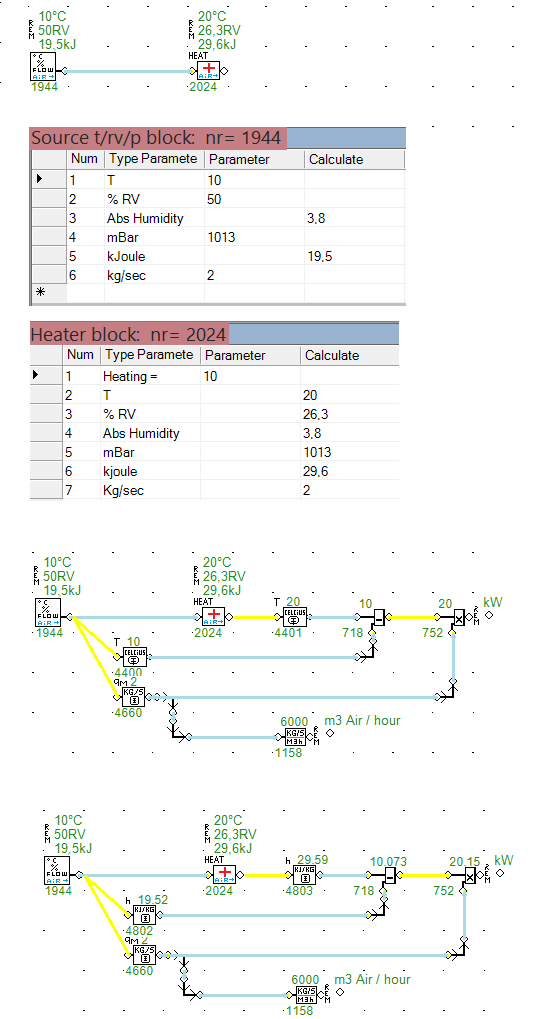
With HVAC Simply the process of heating of air can be easily modeling by a block 'Source air' and a block 'heater' place on the grid. Then we connect these blocks so that air can be heated
Air block: Here we set the parameters for the initial situation at 10 ' C and 50% RH (relative humidity) and Flow 2 kg / s.
Heater block: Then we give in parameter for the heater in the block 'heater'. Here we set a 10 ' C increase in. See that it automatically calculates what the air is doing. The 'heater' block is calculated itself you can see what happens with the air of 10 ' C when it is heated to 20 ' C. The %RH decreases from 50% to 26.3% RH. While absolute humidity remains the same 3.8 g / kg.
Required power
When we want to calculate the power we place additional blocks for measuring the required units for power. Note: these blocks do not affect the model / process and are purely for the measurement of variables / units. Amount of heat flow Q is Q = mass * specific heat * vd air temperature Q = 2kg / s * 1007 * 10 = 20 kW Density at 20 ' C as per 1 m3 of air is 1.2 kg. That gives 2 kg / s> (2/1.2) * 3600 = 6000 m3/hr.
A better way is to get out of the heat content of air enthalpy h = Q = (29.6 kJ - 19.5 kJ) * 2 kg / s = 20.15 kW. This method is shown in the second model alongside.
What happens when 2 kg of air is cooled from 20 'C to 10'C ?
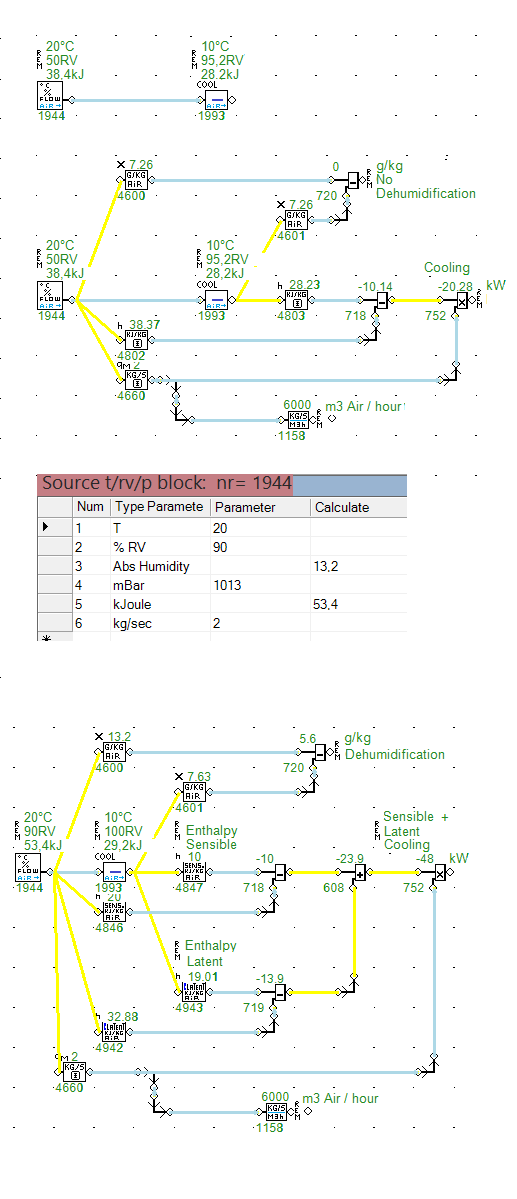
Solution:
We place a block air source and a cooling block and connect them with each other. Then we set the parameters to 20 'C and 50% RH and the Flow 2 kg / s
Then we set the parameter of the cooling block -10 'C . Under the calculation column, you will see that the block automatically calculates what it does to the air. When the temperature is cooling from 20 ' C to 10 ' C the % RH rise from 50% to 95.2% RH while absolute humidity remains the same at 7.26 g / kg The air has become much wetter, with 95% RH, but not yet condensed (condensation limit is 100% RH) the cooling capacity is equal to the heat output of the previous problem
Now we simulate the same cooling with 2 kg of moist air:
Now we see what happens when we change the condition of the block 'source'
We change the % RH from 50% RH to 90% RH :
We now see that the heat content (enthalpy) of the source increases from 38 kJ to 53 kJ.
We also see that the % RH from 90% RH to 100% RH is (the air condenses ).
This will dry the air instead of 13.2 g/kg to 7.63 g / kg.
The cooling capacity is now also increases from 20kW to 48kW.
The heat content of air is composed of sensible heat and latent heat.
The cooling capacity increases because you have to cool down
latent (hidden) heat from the air.
Through place extra blocks enthalpy sensible and enthalpy latent it becomes clearer.
- Sensible content (h = 20 - h = 10) = 10 kJ / kg
- Latent content (h = 32.8-h = 19) = 13.9 kJ / kg
Together is 23,9 kJ * flow van 2kg/s = -48 kW cooling Power Conclusion: Together is 23.9 kJ * mass flow of 2kg / s = -48 kW cooling capacity Conclusion: The more moisture in the air Condense the more latent heat of air (dehumidification) costs extra cooling
Complete list Enthalpy blocks:
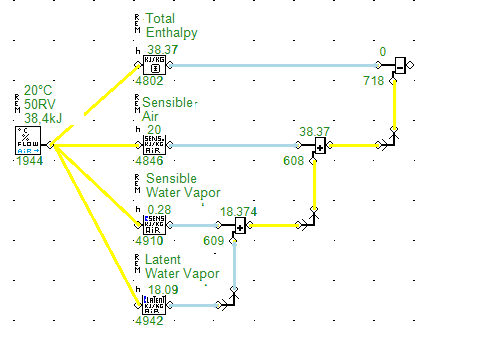
The enthalpy of moist air is composed of three compentences:
1 the sensible heat in the air
2.the sensible heat in the water vapor
3.the latent heat in the water vapor (evaporation heat)
Practical example cooling air:
Per second is 3 kg (wet air) of 28 'C and 50% RH is cooled to 20 'C with a cooling coil bypass factor = 56%. The inlet temperature of the cooling coil is 6 'C and 12 'C return temperature. What is the cooling capacity and how much is dehumidifier ?
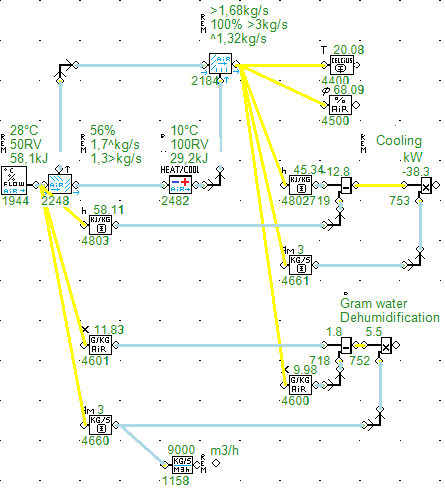
Solution:
The surface temperature of the cooling coil is = ((6 +12) / 2) +1 = 10 ' C. In practice, the efficiency of a cooling coil is not 100%. Cooling coils are dealing with a bypass factor e. Bypass factors range from 65% to 3% for a single row for an eight row cooling coil.
e = (T outgoing - T surface) / (T entry - T surface) * 100% = 56% so, 44% v. air is treated. See block air distribution in 2248 so 44% of 3kg /s is 1.3 kg/s is really chilled. In block 2184, the air mixing air back together
Outcome: / cooling capacity = (H.in: 58.1 - H.uit: 45.3) * 3kg / s = 38 kW This also consists of sensible and latent
- P Sensible =((28'C-20'C)*3kg/s)= 24 kW
- P Latent is 38kw -24 kW= 14 kw
- Dehumidification ((11.8-10) * 3) = 5.5 grams of moisture
Practical example humidify air with water:
In 20 m3 of air at 20 'C with a RH of 40%, 45 grams of water spraying. What happens to the air temperature, absolute humidity and enthalpy?
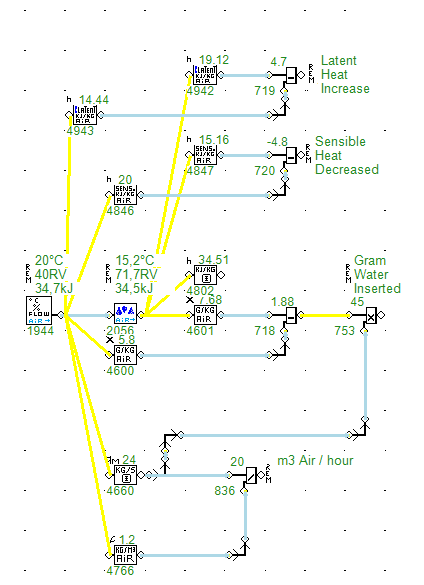
Solution:
First, the 20 m3 of air must be transform to kg air. The density of air at 20 ' C = 1.2kg/m3. Inside HVAC Simply, there exist a block that performs this calculation see block kg/m3 air there is the density of 1.2 kg/m3. Then we share that with the mass flow kg / s, and we obtain the volume m3 of air at 20 ' C. Then we can set the mass flow within the parameters of the block 'air source' (No. 1944) at 24 kg/s. Therefore 24/1.2 = 20 m3 air. If we want to determine how much we should moisten per kg air we share 45 grams of moisture / 24 kg / s. So 45/24 = 1.88 g per kg of air.
We can set this in block (2056) water wetting g/kg 1.88. With x block (absolute humidity) we can verify this. 7.68 g /kg Secondary Air - Air Primary 5,8 g /kg = 1.88 g /kg humidification.
We see that the total enthalpy hardly changed from 34.7 to 34.5 kJ kJ. This is because it is an adiabatic process. (A process is adiabatic if no heat is exchanged with the surroundings.) We see that the Latent heat increases from 14.4 to 19.1 kJ kJ. However, the sensible heat decreases from 20kJ to 15.1 KJ. The total heat remains the same.
The air temperature does change from 20 ' C to 15 ' C. The evaporation of water takes energy and thereby decreases the air temperature. Adiabatic cooling is also called evaporative cooling. The evaporation of 1 liter of water supplies 0.7 kW cooling. Only if the humidity is too high, you can not apply it.
Practical example humidifying air with steam:
In 20 m3 of air at 20 ' C with an RH of 40%, 45 grams of steam atomized. What happens to the air temperature, absolute humidity and enthalpy?
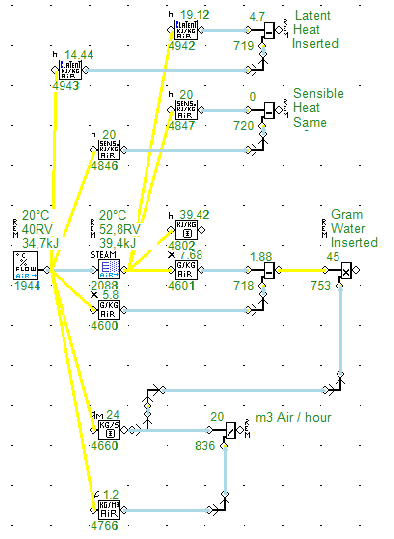
Solution :
7.68 g/kg Secondary Air - Air Primary 5,8 g/kg = 1.88 g/kg humidification. We see that the total enthalpy change of 34.7 kJ to 39.4 kJ. We see that the Latent heat (latent heat) increases from 14.4 to 19.1 kJ kJ. And the sensible heat remains hetzelde of 20 kJ to 20 kJ. The air temperature is kept the same at 20 ' C to 20 ' C.
When wetted by means of the steam heat of vaporization present in the steam will be added to the air. Together with the liquid to wet heat This means that no heat is extracted. From the air present However, it is even added to some heat. There depending on the temperature of the steam Hygiene reasons this is a safe humidification since no bacteria (Legionella) can possible life to the high temperature of > 100 ' C steam.
Practical example of calculating capacity circulation pump:
Data: Flow Q = 100 m3 / h head H = 12m Pump Efficiency = 75%
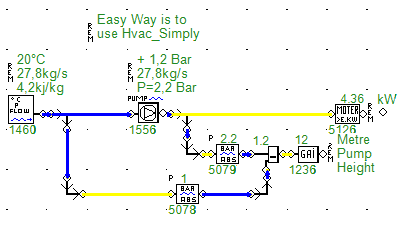
Solution:
Formula is P=((p*g*Q*H)/1000*u
- P =Power
- p = liquid density (kg/m3) in this case water = 1
- g = acceleration due to gravity (9.81) m / s 2
- Q = Flow l/s (100/3.6)=27,8
- H = Head 12 meters
- u = Efficiency of the pump 75%
Solution Hvac Simply:
Place block source water (1460) and connects the pump to block (1556). Fill in source water block (1460) pressure p = 1 bar and flow 27.8 kg / s. Fill in block pump (1556) head of 1.2 and yield 75%. Connect now block Engine> E.kw (5126) to block Pump. It automatically calculates the capacity in kw. Place blocks measuring bar and abs at the source and at the pump. Now you can subtract this and see the differential pressure. These measurements together 1.2 bar * gai (block gain setting * 10) = 12 meters head pump.
Practical example power calculation Fan:
Data: Flow Q = 1500 m3 / h head H = 10 mbar Return fan Efficiency= 60%
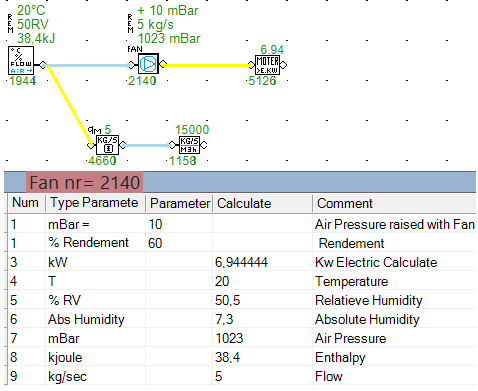
Solution :
Connects a source block air with a block Fan After a gage block Engine> E.kw to block fan. Set source air mass flow to 5 kg / s. With block KG / s> M3 / h, he calculates M3 / in this case 1500 m3 / h. See settings block fan nr = 2140 under parameter. Here we fill in head and efficiency of the Fan. Outcome is electric power 6.94 kW.
Practical example of mixing two air streams:
Data:
Flow 1: 2 kg/s 5'C 38%RV
Flow 2: 1 kg/s 22'C 40%RV

Solution Hvac Simply:
Place block air source (1944) and connects it to block air mixing (2184). Fill in block air source (1944) Enter parameters: flow = 2 kg / s temp = 5 ' C Humidity = 38% RH Place Block air source (1945) and connects it to block air mixing (2184). Fill in parameters source air block (1945) Enter parameters: flow = 1 kg / s temp = 22 ' C, humidity = 40% RH Enter block mixing air (2184) mixing parameter amount to 100%. He calculates automatically the mixing off. Place blocks measuring temp,% rh, Abs and moisture kg / s at the output of mixing pad.
Mixing two air flows with condensation:
Data:
Flow 1: 1 kg/s -10'C 60%RH
Flow 2: 1 kg/s 20'C 80%RH

Solution Hvac Simply:
Often happens that there are wet spots occur somewhere in the air treatment plant by the condensation of mixing of two air streams. With Hvac Simply you can explain this easily.
Place block air source (1944) and connects it to block air mixing (2184). Fill in block air source (1944) Enter parameters: flow = 1 kg / s temp = -10 ' C Humidity = 60% RH Place block air source (1945) and connects it to block air mixing (2184). Fill in source air block (1945) Enter parameters: flow = 1 kg / s temp = 20 ' C, humidity = 80% RH Enter block mixing air (2184) mixing parameter amount to 100%. He calculates automatically the mixing off. Place blocks measuring temp,% rh, Abs and moisture kg / s at the outlet of mixing pad. You can see that the% RH increased air after mixing at 100% RH (condensation point) by placing additional measuring blocks you can now easily calculate difference in total fluid primary air - air moisture after mixing. 6.3 grams primary - 6.19 grams mixed air = -0.458 g condensation
Heatpump calculation flow energy :
Data:
Evaporator air flow: 1 kg / s 20 ' C, 80% RH
Flow Condenser Airflow: 1kg / s 20 ' C, 50% RH
Cop heat factor 4
Cooling to 10 ' C
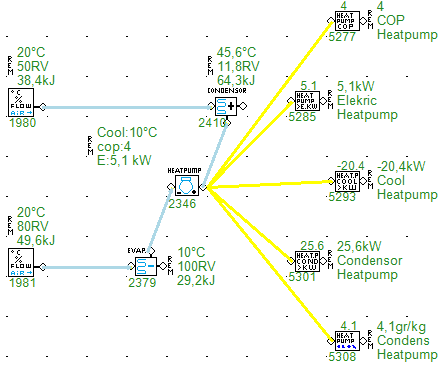
Solution Hvac Simply:
This model calculates the amount of electricity in kw automatically from the compressor to air of 20 ' C to cool down to 10 ' C. Electric heat pump 5.1 . The cooling system is a cop: 4 * 5.1 = 20.4 kW. Condenser heat is (Electric heat pump 5.1 kW + 20.4 kW cooling capacity) = 25.6 kW, it also calculates how much he condenses per kg of air in this case 4.1 grams of moisture per kg of air.
Three same models only temperature of the source changes
As a result, other COP (Coefficient of Performence).
Profit Changes Strong !!!!
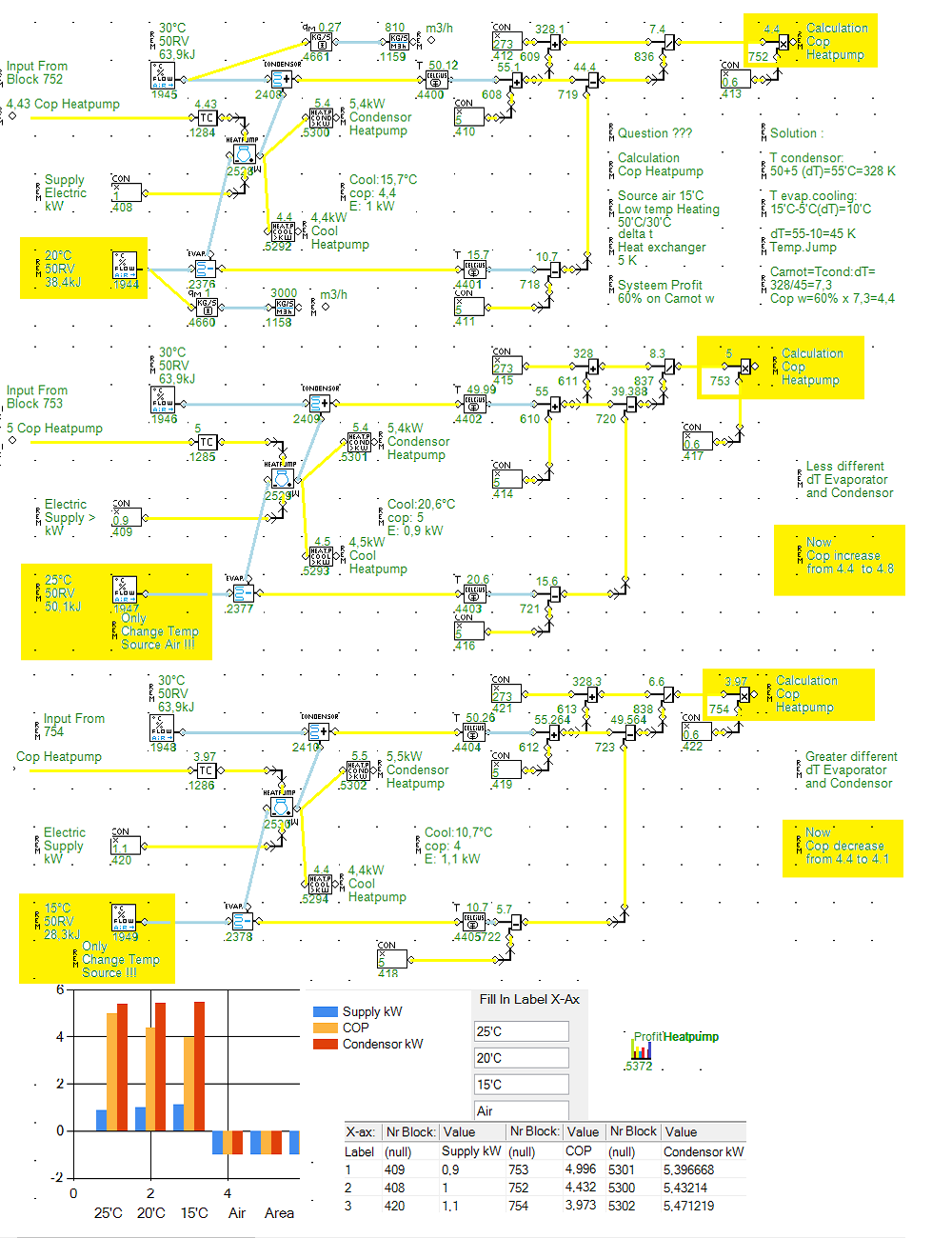
If jou have a question you can mail to me:
info@mollierdiagram.com
If you purchase Hvac_Simply you get more examples,
many more files with examples of complete Air-conditioning installations.
Examples of Hvac_Simply
Or look at a Demo Movie to make a Crossflow model in 4 munites.